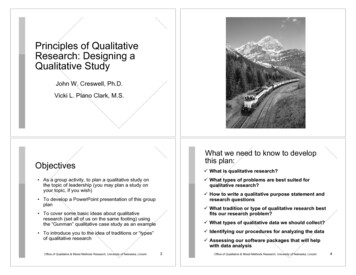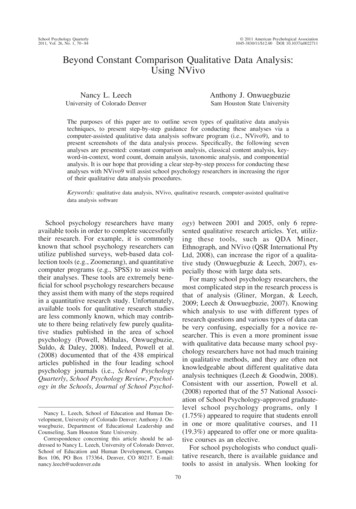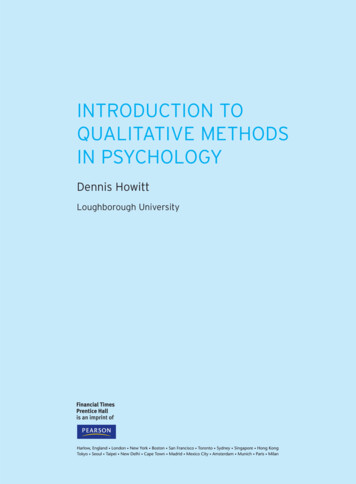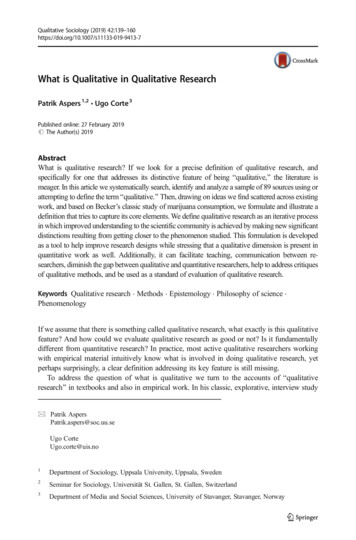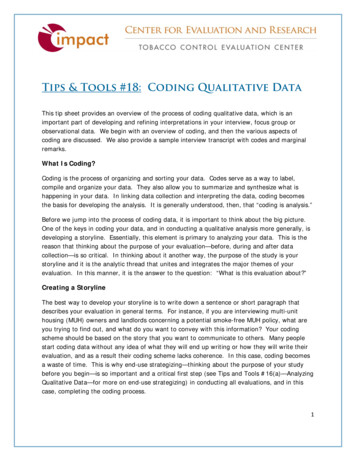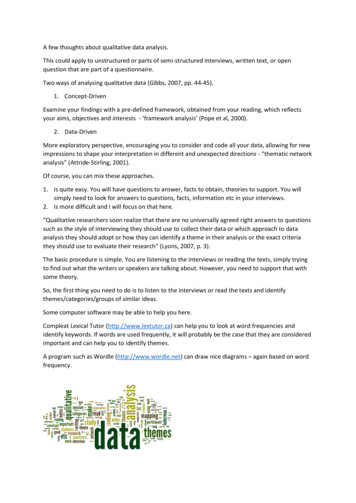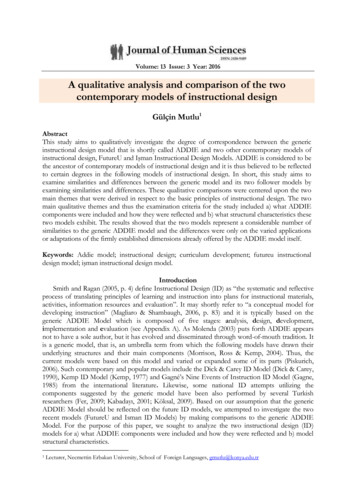
Transcription
Volume: 13 Issue: 3 Year: 2016A qualitative analysis and comparison of the twocontemporary models of instructional designGülçin Mutlu1AbstractThis study aims to qualitatively investigate the degree of correspondence between the genericinstructional design model that is shortly called ADDIE and two other contemporary models ofinstructional design, FutureU and Işman Instructional Design Models. ADDIE is considered to bethe ancestor of contemporary models of instructional design and it is thus believed to be reflectedto certain degrees in the following models of instructional design. In short, this study aims toexamine similarities and differences between the generic model and its two follower models byexamining similarities and differences. These qualitative comparisons were centered upon the twomain themes that were derived in respect to the basic principles of instructional design. The twomain qualitative themes and thus the examination criteria for the study included a) what ADDIEcomponents were included and how they were reflected and b) what structural characteristics thesetwo models exhibit. The results showed that the two models represent a considerable number ofsimilarities to the generic ADDIE model and the differences were only on the varied applicationsor adaptations of the firmly established dimensions already offered by the ADDIE model itself.Keywords: Addie model; instructional design; curriculum development; futureu instructionaldesign model; işman instructional design model.IntroductionSmith and Ragan (2005, p. 4) define Instructional Design (ID) as “the systematic and reflectiveprocess of translating principles of learning and instruction into plans for instructional materials,activities, information resources and evaluation”. It may shortly refer to “a conceptual model fordeveloping instruction” (Magliaro & Shambaugh, 2006, p. 83) and it is typically based on thegeneric ADDIE Model which is composed of five stages: analysis, design, development,implementation and evaluation (see Appendix A). As Molenda (2003) puts forth ADDIE appearsnot to have a sole author, but it has evolved and disseminated through word-of-mouth tradition. Itis a generic model, that is, an umbrella term from which the following models have drawn theirunderlying structures and their main components (Morrison, Ross & Kemp, 2004). Thus, thecurrent models were based on this model and varied or expanded some of its parts (Piskurich,2006). Such contemporary and popular models include the Dick & Carey ID Model (Dick & Carey,1990), Kemp ID Model (Kemp, 1977) and Gagné’s Nine Events of Instruction ID Model (Gagne,1985) from the international literature. Likewise, some national ID attempts utilizing thecomponents suggested by the generic model have been also performed by several Turkishresearchers (Fer, 2009; Kabadayı, 2001; Köksal, 2009). Based on our assumption that the genericADDIE Model should be reflected on the future ID models, we attempted to investigate the tworecent models (FutureU and Isman ID Models) by making comparisons to the generic ADDIEModel. For the purpose of this paper, we sought to analyze the two instructional design (ID)models for a) what ADDIE components were included and how they were reflected and b) modelstructural characteristics.1Lecturer, Necmettin Erbakan University, School of Foreign Languages, gmutlu@konya.edu.tr
6155Mutlu, G. (2016). A qualitative analysis and comparison of the two contemporary models of instructional design. Journalof Human Sciences, 13(3), 6154-6163. doi:10.14687/jhs.v13i3.4350MethodThis study aims to qualitatively compare the two instructional design (ID) models by reflectingupon their suitability or correspondence to the generic ADDIE Model. Hence, the researcher firstderived two criteria or themes based upon the literature review on the basic principles andcharacteristics of instructional design to investigate and compare the models. These two themeswere a) what ADDIE components were included and how they were reflected and b) whatstructural characteristics these models possess. The qualitative data on the two models werecollected with regard to these two themes derived and the following comparative analyses wereperformed. The following presents these qualitative results first in respect to the models and thento two examination criteria.Results on the FutureU ID Modela) What ADDIE Components Were Included and How Were They Reflected?In the FutureU ID Model for Online Learning developed by Whitmyer (1999), it seems thatshe has taken the key design cycle stages described by ADDIE. Her ID model is characterized byfour phases which are discovery, design, development and delivery rather than the five-phased structure ofADDIE. The analysis stage of ADDIE is the same as the Discovery Phase of FutureU. Whitmyer(1999) has reported five steps for this phase. In comparing what is actually worded out in the stepsof the Discovery phase, the steps seem very similar to the ones expressed by the ADDIE with itsAnalysis stage. Whitmyer (1999) summarizes the basic questions posed by ADDIE Model in thebrief literature review part of her article. In comparing the two main stages, they share a lot incommon. It appears that Whitmyer (1999) has just taken, paraphrased and added new questions towhat ADDIE has suggested. Table 1 shows the similarities of the two as Whitmyer (1999, pp. 1, 2& 6) presented in her article. However, in looking at the second and third stages Whitmyer’s IDModel, it is apparent that she has added the intended learning outcomes (ILO), which is acontemporary term used for objectives. As she designed a course (an online one), with the ILOterminology, it seems that she has also employed some terminology from the ID course modeldeveloped by Posner and Rudnitsky (1997).Table 1The Comparison of the Analysis (ADDIE) and Discovery (FutureU) StagesADDIE ID ModelFutureU ID ModelWho is your audience? (Who are yourStep 4: Who will your students be?learners?)What is the purpose of the instruction?Step 1: What is required by yourcurriculum?What knowledge, skills, or attitudes mustStep 2: What learning outcomes are yoube taught?looking for?Step 3: What learning objectives will resultin those outcomes?How much can you cover within theconstraints for the learning unit in question(e.g., tutorial, workshop, course, program,degree, etc.)?Step 5: What are the available resources?
6156Mutlu, G. (2016). A qualitative analysis and comparison of the two contemporary models of instructional design. Journalof Human Sciences, 13(3), 6154-6163. doi:10.14687/jhs.v13i3.4350Whitmyer (1999) starts considering the ILO from the very beginning, while the ADDIE Modelleaves it to the later step of Design. ADDIE ID Model exhibited the content (What knowledge,skills, or attitudes must be taught?) as a seperate stage while Whitmyer (1999) included it under thetitle of available resources. In further looking at the design stages of the two models, both modelscenter on the instructional objectives. That is, composing the instructional objectives is a mainprinciple of the design stage of the ADDIE generic model and it is also applied to the FutureU.FutureU applies the objectives component as it should be with the ADDIE, but it further developsit in the form of a hierarchical relationship. FutureU ID Model does not suggest a complete visualmental model. Whitmyer (1999) attempts to create models or figures for only two of the fourphases of the ID model. These phases are the design phase and the delivery phase (see Appendix Bfor the mental model of the two phases). The components of the model for the design phase islinked by arrows showing the linear nature of the relationship, which is again one of the mainprinciples represented in the ADDIE generic ID model. Whitmyer (199) further develops thisphase by adding eight special considerations (e.g. technology, time management, phasing of thetechnological developments and facilitation) drawn according to the learning environment andsituation of the course she sought to develop. As she does not present them within a visual modeland provided no further explanation for the operation of these considerations in the text, it isdifficult to comment on the nature of horizontal and vertical relationships of the considerationswithin the ID model. However, from the textual information provided, it is clear that it also followsa step-by-step design. The development phase of the FutureU has been drawn a lot from thegeneric model of ADDIE in that both focus on the process of specifying how it is to be learned inthe development phase and also of the development of materials and media. The delivery phase ofthe FutureU and the implementation stage of the ADDIE centers on the process of creation of thelearning environment for the learners. As ADDIE is a generic model with no developed furtherrationale and steps, Whitmyer (1999) has herself further developed five stages suited to the natureof online courses (see Appendix C for a visual model of the delivery phase).The FutureU ID model has four phases in comparison to the five phases suggested by theADDIE. Thus, it is not difficult to understand why the assessment component has not beenmentioned in the FutureU. Though FutureU ID Model is recommended for the online courses, byconvention there should be an evaluation section; however, there is no similar stage. The FutureUModel says nothing for the determination of the adequacy of the (online) instruction. Therefore,one can say that the evaluation dimension of the generic ADDIE model has not been reflected inthe FutureU ID model.b) What Are the Structural Characteristics of the Two Models?The structural characteristics refer to the analyses of the relationships between the componentsincluded in the ID models. Though several other categories of visual representations to representthe ID models (metaphoric and conceptual-dynamic as suggested by Magliaro and Shambaugh,2006), the two models discussed above in detail were both included in the conceptual-sequentialcategory. As is also pointed out above, both models depict a liner, step-by-step process. To showsuch a relationship between the components of the models, usually arrows and/or lines in anordered fashion are employed in both ID models (the model is not well developed (not full) for theFutureU ID model). In both models, “the rectilinear row of boxes” (Gustafson & Branch, 1997, ascited in Magliaro & Shambaugh, 2006, p. 93) are apparent. Another striking characteristic is the“inherent hierarchy of activity” (Magliaro & Shambaugh, 2006, p. 93) with the FutureU model. Inother words, as there is no full visual model for the FutureU ID model but only two of the phasesare depicted with some kind of a visual representation, it seems that these two phases are moreimportant than the other phases so they deserved more attention and visualization. For the othermodel, all of the stages (components) appear to be given equal importance. For both models, itseems that each earlier step affects the next one somehow, but these steps are also wholes withinthemselves.
6157Mutlu, G. (2016). A qualitative analysis and comparison of the two contemporary models of instructional design. Journalof Human Sciences, 13(3), 6154-6163. doi:10.14687/jhs.v13i3.4350Results on the Işman ID Modela) What ADDIE Components Were Included and How Were They Reflected?The major rationale behind the Isman ID Model originates from the significance of theinstructional planning and the implementation process within a learning situation. İşman (2005)appears as one of the instructional designers who take planning, developing, implementation andevaluation as the most important components of the instructional design model. Given the theoriesconcerning the instructional design model, it appears that there are some components or insightstaken from behaviorism, cognitivism and constructivism. The idea of behaviorism is reflected intothe process as considering the stimulus-response, reinforcement concepts as well as theenvironmental conditions. Cognitivism is taken into consideration when motivation, intellectuallearning process, experiences and contents are concerned and the signs of constructivism becomeapparent in the roles of both teachers and learners in the process.When the influence or reflection of ADDIE components in the model is questioned, thereappear many similarities in terms of the approach on which both models are based and the stagesof the instructional process but there are also some important differences. It is an undeniable factthat models are similar in that they are both based on a systematic approach, enabling the designersto follow an organized procedure. As for the phases of each model, it seems that most of the ideasoverlap in both designs; however, there are some components of ADDIE design which are notreflected on the model by İşman.İşman (2005) designs his model according to five main steps – input, process, output, feedback andlearning (see Appendix D for the Isman Model) whereas in the ADDIE Model the steps are namedas analysis, design, development, implementation and evaluation. The similarities and the differences betweentwo models are shown in Table 2.Table 2The Comparison of Isman and ADDIE ID ModelADDIE ModelAnalysisneeds assessment (1)problem identification*task analysis (2)Designwrite objectives (3)develop test items (4)plan instruction (5)identify resources (6)Developmentwork with procedures*develop workbook, flowchart, program*Implementationteacher training*tryout (7)Evaluationrecorded time data (8)interpret test results (9)survey graduates*revise activities (10)IŞMAN MODELInputidentify needs (1)identify contents (2)identify goals and objectives (3)identify evaluation materials (4)identify teaching methods (5)identify instructional media (6)Processtest prototypes*redesigning of instruction*teaching activities (7)Outputtesting (8)analyze results (9)Feedbackrevise instruction (10)LearningNote. Numbers represent similarities and the symbol “*” the differences; The ADDIE part wastaken from http://www.cs.ucy.ac.cy/ nicolast/courses/cs654/lectures/IDmodels.pdf
6158Mutlu, G. (2016). A qualitative analysis and comparison of the two contemporary models of instructional design. Journalof Human Sciences, 13(3), 6154-6163. doi:10.14687/jhs.v13i3.4350As is seen from the figure, the analysis and design steps of the ADDIE Model are combinedunder one title in ISMAN Model and the sub-dimensions are similar except the “problemidentification” phase in the ADDIE Model. However, the development part of the ADDIE Modelis not reflected in ISMAN Model. The implementation phase of the ADDIE model and theprocess step of the ISMAN Model have only one common point, that is, the implementation of theactivities. As for the assessment aspect, the evaluation step in ADDIE Model seems divided intotwo categories in ISMAN Model – output and feedback. All the sub-dimensions are similar except“the survey graduates” phase in the ADDIE Model. The last stage of the ISMAN Model (learning)doesn’t have a specific place in the ADDIE Model; nevertheless, both models check whether thelearning has occurred or not throughout the whole process.b) What Are the Structural Characteristics of the Two Models?The designer describes his model as a five-step systematic planning process. The first step isnamed as “input” where needs, contents, goals and objectives, teaching methods, materials andinstructional resources are clarified. In the second step, that is, the “process” stage, the main focusis on pretests, organization and revision of activities. The importance of this step is emphasized bythe designer in that the success of the process directly affects the attainment of goals. The third stepnamed as “output” involves the assessment and the analysis of the results where the designer aimsto investigate whether the target skills are demonstrated, goals and objectives are attained. The nextstep is based on the information gathered through “feedback” enabling the revision of theinstructional process. After making modifications according to the feedback results, the last step,“learning” occurs and this stage is where it is made certain that the students have acquired theknowledge, skills and ideas aimed by the instructional plan.Given the structure presented and the explanations of the designer, it can be claimed that thereis a dynamic relationship between all steps, thus meaning that the design is open to revision andmodifications all the time and the designer is able to change the direction of his plan according tothe needs of the learning environment.DiscussionGiven the above discussion, the first implication would be that both of the contemporarymodels have drawn a lot from the generic ADDIE ID Model. That is, most stages or componentsof the ADDIE has been taken and often developed further in both ID models. However, thereappear some components that have been eliminated. For instance, FutureU lacks any evaluationcomponent throughout the design process. Likewise, İşman Model also lacks the developmentstage in the ADDIE Model. Furthermore, though some components of the ADDIE Model havebeen drawn by the two contemporary models, these components were either developed further byadding more details to the generic ones or located differently within the instructional developmentcycle. For example, analysis and design components of the generic ADDIE ID model were mergedin the İşman ID Model in the new title of input. In such attempts, the generic characteristics of theADDIE Model were kept and thus the changes made were often substantial in that only the titlesor more details were added over the generic ideas. Therefore, we still observe that thecharacteristics put forth by the ADDIE Model that are analysis, strategy development,implementation and evaluation continue to be the essence of the most contemporary ID models.In other words, it would be wise to suggest that ADDIE Model could be accurately termed “ACommon Model of Instructional Design”. However, the instructional design literature has brieflyshown us that this ID model is a universal and generic one (Magliaro & Shambaugh, 2006).However, there would be some new attributions of its follower contemporary models such as theinclusion of some new components or terms and such attempts were clearly observed in the twothat were evaluated for the purposes of this study. As Smith and Ragan (2005) put forth, aninstructional designer is similar to an engineer. Both plan and design their work for the end-users.In this process, though, they are humans and thus creative and different from one another, which
6159Mutlu, G. (2016). A qualitative analysis and comparison of the two contemporary models of instructional design. Journalof Human Sciences, 13(3), 6154-6163. doi:10.14687/jhs.v13i3.4350can expectedly make their products different than one another. In short, the developmentalattempts of instructional designers will result in different variations of these models. However,since the instructional designers will plan their models based on the general principles of instructionand teaching (Smith & Ragan, 2005, p. 4) and also of the existing theoretical background incurriculum development during the planning stage, there would inevitably be some expectedsimilarities. Andrews and Goodson (1980) and Gustafson and Branch (1997) offer a more detailedand extensive analysis on some other instructional design models (i.e. more traditional ID models)and not only curriculum developers or ID professionals but also teachers themselves not being onlypassive “transmitters of curricula” anymore (Kabadayı, 2016, p. 10) are advised to utilize suchresources for a better design and application of their design processes.ReferencesAndrews, D. H. & Goodson, L. A. (1980). A Comparative Analysis of Models of InstructionalDesign. Journal of Instructional Development, 3, 2-16.Dick, W. & Cary, L. (1990). The Systematic Design of Instruction, Third Edition, Harper CollinsFer, S. (2009). Social constructivism and social constructivist curricula in Turkey for the needs ofdifferences of young people: Overview in light of the PROMISE project. In T. Tajmel & S.Klaus (Eds.), Science education unlimited: Approaches to equal opportunity in learningscience (179-199). Munster: Waxmann Verlag co. Publisher.Gagné, R. (1985). The Conditions of Learning and the Theory of Instruction (4th ed.). New York: Holt,Rinehart, and Winston.Gustafson, K, L. & Branch, R. M. (1997). Survey of Instructional Design Models (3rd ed.). Syracuse:ERIC Clearing House on Information & edMay24,2011,fromhttp://www.cs.ucy.ac.cy/ yı, A. (2001). Bilişsel öğrenme biçemleri ve öğrenci merkezli bir yabancı dil öğretim modeliönerisi. Yayınlanmamış doktora tezi. Konya: Selçuk Üniversitesi Sosyal Bilimler Enstitüsü.Kabadayı, A. (2016). A Suggested In-service Training Model Based on Turkish Preschool Teachers’Conceptions for Sustainable Development, Journal of Teacher Education for Sustainability, 18(1),5-15, DOI: 10.1515/jtes-2016-0001.Kemp, J. (1977) Instructional Design: A Plan for Unit and Course Development. Belmont: Fearon-PitmanPub.Köksal, M.S. (2009). An instructional design model to teach nature of science, Asia-Pacific Forum onScience Learning and Teaching, 10(2), 1-18.Molenda, M. (2003). The ADDIE Model. Retrieved May 24, 2011, fromhttp://www.indiana.edu/ molpage/The%20ADDIE%20Model Encyclo.pdfMagliaro, S. G. & Shambaugh, N. (2006). Student models of instructional design. EducationalTechnology Research & Development, 54(1), 83-106.Morrison, G. R., Ross, S. M., & Kemp, J. E. (2004). Designing Effective Instruction (4rd ed.). New York:John Wiley & Sons Inc.Piskurich, G. M. (2006). Rapid Instructional Design: Learning ID Fast and Right. San Francisco: Pfeiffer.Posner, G. and Rudnisky, A. N. (1997). Course Design: A Guide to Curriculum Development for Teachers.New York: Longman.Smith,P. L. & Ragan T. J. (2005).Instructional Design (3 rd ed.).Hoboken, NJ: John Wiley & SonsInc.Whitmyer, C. (1999). Instructional Design for Online Learning. FutureU Press, Available structional design for online learning.pdf
6160Mutlu, G. (2016). A qualitative analysis and comparison of the two contemporary models of instructional design. Journalof Human Sciences, 13(3), 6154-6163. doi:10.14687/jhs.v13i3.4350Appendix AThe ADDIE Model (from the Instructional Design Models, n.d.)
6161Mutlu, G. (2016). A qualitative analysis and comparison of the two contemporary models of instructional design. Journalof Human Sciences, 13(3), 6154-6163. doi:10.14687/jhs.v13i3.4350Appendix BUnits of learning and Lesson Components of the Design Phase of the FutureU Model (fromWhitmyer, 1999, p.8)
6162Mutlu, G. (2016). A qualitative analysis and comparison of the two contemporary models of instructional design. Journalof Human Sciences, 13(3), 6154-6163. doi:10.14687/jhs.v13i3.4350Appendix CVisual Model of the Delivery Phase of the Futureu ID Model (from Whitmyer, 1999, p.11)
6163Mutlu, G. (2016). A qualitative analysis and comparison of the two contemporary models of instructional design. Journalof Human Sciences, 13(3), 6154-6163. doi:10.14687/jhs.v13i3.4350Appendix DThe Işman Model (from İşman, 2005, p. 49)
contemporary models of instructional design Gülçin Mutlu1 Abstract This study aims to qualitatively investigate the degree of correspondence between the generic instructional design model that is shortly called ADDIE and two other contemporary models of instructional design, FutureU and Işman Instructional Design Models.
